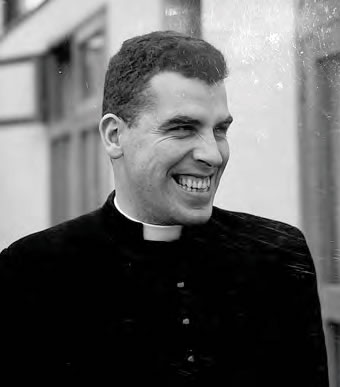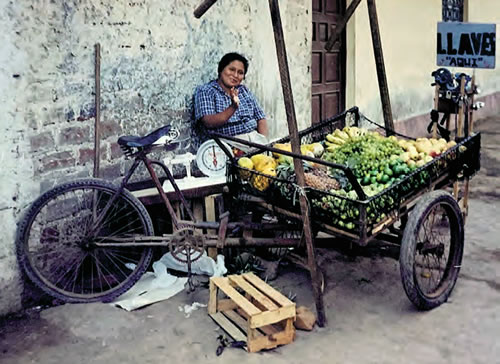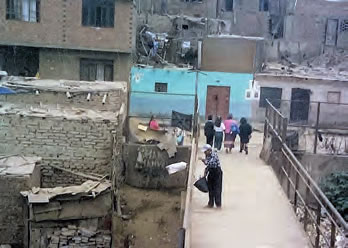
Keeping Pace with One of the World's Fastest Growing Cities: Lima, Peru
“Ever seen a mushroom grow? asked our gardener one morning in the grounds of the Columban Center House in Peru, as he pointed out to some of us a particularly fine example. “Sprouts up overnight. Incredible.” “Hmmm, just like Lima,” observed Fr. Dermot Carthy. He should know. During his sixty years in Peru he has seen its capital city explode in size, a perfect example of what are generally known as “mushroom cities.

“Mushroom city” was a term coined in the latter part of the last century to describe those towns in Africa, Asia and Latin America which in the post-war period experienced spectacular rates of expansion, rapidly becoming mega-conurbations. Classic examples are those of Tokyo, Mumbai, Lagos, and Mexico City. But for speed of growth, few can match that of Lima – and the mission of the Columban Fathers has had to “mushroom” apace.
The figures are staggering. When Fr. Dermot arrived from Ireland in 1960, Lima had a population of just over one million. In 2020 it was nearly ELEVEN million, a tenfold increase in just sixty years.
The Columbans had first come to Peru a few years before Fr. Dermot’s arrival, in 1952. The bishops of Peru had asked us to set up a parish on what was then the northern edge of the town of Lima. There was one large neighborhood of about 40,000 people, built in the 1940’s. However, the area was mainly rural, made up of some 15 estate farms (“haciendas”), which grew maize and cotton on irrigated desert land and employed a lot of seasonal labor drawn from the nearby Andes mountains.
A special remit was granted by Rome to name the parish after Martín de Porres. Permission was needed because he wasn’t a saint yet! He wouldn’t be canonized until 1962. Martín was chosen because he’d been from Lima. Also, the three Columban priests who took over the parish were from Ireland, where Blessed Martín already enjoyed a strong devotional following – stronger, possibly, than in his native Peru.
So, just pause a moment. We are in 1952 with one parish, three priests, no church and 40,000 people (maybe up to 60,000 at harvest time).

Fast-forward to 2020. That “parish” is now the best part of an entire diocese, the Diocese of North Lima, one of the most populous in the world, with 47 parishes, over 100 priests, in excess of 200 churches and chapels…and a population of NEARLY THREE MILLION!
“If you think that is amazing,” observes Fr. Dermot, “remember that of those 47 parishes, over half of them were founded by the Columbans!” He knows all of them, and has worked in six, in some more than once.
“Thrown in at the deep end,” perhaps best describes how he started. Born in Dublin, Fr. Dermot joined the Columbans at 17, was ordained at 23 and shipped off to South America almost immediately. Picked up at Lima airport, he was told that, if it was alright with him, he was “on” for rosary and benediction that same night.
“There was no formal language training given beforehand in those days,” he explains. “As everything was done in Latin back then, it was felt you didn’t need the local language in order to get started. You could do Masses and Baptisms and the rest, straight off. As for talking to the people, it was reckoned you’d pick that up as you went along.”
Fortunately, he HAD taken some Spanish classes in Ireland, and had, “spent a summer hitch-hiking around Spain,” so he wasn´t entirely clueless on the language front.
Experience swiftly followed experience for Fr. Dermot. The mushroom city miracle was underway, and the Columbans would fail to adapt at their cost. This was the epoch of the land invasions, when huge chunks of desert or farmland would be occupied (often, literally, overnight) by hundreds of flimsy wicker-work cabins. The squatters would then look to slowly improve their dwellings as time went on, and wait until local authorities belatedly legalized the occupations and installed public utilities.

And so it was that just two years after his ordination and arrival, Fr. Dermot found himself pastor of a brand new, densely packed and desperately poor parish. “The Virgin Mediatrix of Villa María,” was the posh name for a recently occupied former quarry and rubbish dump, “populated by 10,000 people and 4,000 pigs.” A simple mud-brick building served as parish house, chapel and clinic. The latter was staffed by Anglican volunteers, a rare example of ecumenism well before the practice generally caught on.
There was no electricity or water supply. Sewage disposal was via an open drain and an equally foul river. Fr. Dermot fondly remembers a certain daily ritual. “Each morning, the children were sent out with the household potties. They were supposed to empty the night soil into the river. Mind, a lot of them couldn’t be bothered, and just tipped the stuff out a block or two from home. Consequently, the parish was always pervaded by, “a special kind of perfume.”
Fr. Dermot´s was the only house in the parish with a generator. This, in turn, powered the sole television set in the parish. “We became the local cinema. All the neighborhood kids appeared each night outside our window, dragging bricks they used as seats. Sat there happy as anything. Couldn’t hear the sound, but just gawped at the screen. Then cleared off when the generator shut down bang on ten.”
It wasn´t long before Fr. Dermot was called on to serve an even bigger parish, as the invasions spread out across a nearby plain set between two hill ranges. Then, as all available flat land was used up, the occupations spread up the hills. Columban parishes followed them and soon, inevitably, so did Fr. Dermot.
It wasn’t until 1989 that his wandering finally ended, when he took on a “relatively small” parish (half on the plain, half on the mountain side) of “just” nine churches and chapels.
And there he remains today, still priest in charge, at the tender age of 85. Living evidence of Columban mission in Mushroom City.
Father Dermot Carthy is an Irish Columban who has worked in Peru since 1960. Father John Boles is an English Columban who has been in Peru since 1994.


 The Columbans are a society of missionaries, including priests and lay people, who minister to people of various cultures as a way of witnessing to the universal love of God.
The Columbans are a society of missionaries, including priests and lay people, who minister to people of various cultures as a way of witnessing to the universal love of God.